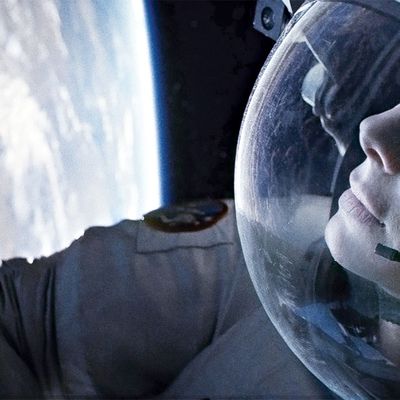
On one level, Gravity is nothing new: state-of-the-art Hollywood technology in the service of an old-fashioned supernatural (i.e., religious) theme. The premise: Two shuttle astronauts played by two of our biggest stars (Sandra Bullock, George Clooney) get marooned in space when speeding debris from an exploded Russian satellite takes out their craft and kills everyone else, on- and off-board. So the drifting, shell-shocked, motion-sick medical engineer, Dr. Ryan Stone (Bullock), and the gregarious veteran astronaut, Matt Kowalski (Clooney), must find a working shuttle to get them to EarthÔÇöfast. Possibly itÔÇÖs in the nearby Russian space station, possibly not. ItÔÇÖs a mess up there. Woven amid the multiple bombardments and cliffhangers is a stark spiritual odyssey: A woman who is dead inside must find (or refind) her faith, letting go to be born again. (Twelve-steppers like to say, ÔÇ£Let go and let God.ÔÇØ) The movie is as cornball as all get-out andÔÇöonce you discern the narrative arcÔÇöas predictable.
But then thereÔÇÖs the part thatÔÇÖsÔÇöas we serious cinephiles like to sayÔÇöinfuckingcredible.
The first shot of Gravity is very, very long and entirely sinuous. We see a slice of the Earth and then a dot that turns out to be a shuttle moving toward us, faster than we anticipate, with three figures attachedÔÇötwo working on the craft, one floating free. Of course it wasnÔÇÖt done in real timeÔÇöitÔÇÖs computerizedÔÇöbut itÔÇÖs still one (count it) shot that goes from macro (the planet) to almost micro (a dislodged bolt floating into the camera). ItÔÇÖs in these first pre-catastrophe minutes that the real and mind-expanding subject of Gravity manifests itself: the Higher Math.
My own puny brain goes haywire attempting to sort out the variables, but computer programmers and Princeton mathematicians will find their own version of heaven onscreen. Is the camera moving toward the shuttle or vice versa or both? Or is it the EarthÔÇÖs rotation thatÔÇÖs controlling the shot? Or are all three variables working in tandem? Are there equations (or logarithms) for the way the bodies drift vis-├á-vis the EarthÔÇÖs rotation in zero gravity while the stars move in the background? What about the charactersÔÇÖ limbs, weightless but subject to other forces, internal and external? How do you determine the momentum and impact of an astronautÔÇÖs body as it collides with another or the side of a spacecraft with a head-rocking oomph? What about the debris? The shuttle comes apart the way something really would in oxygenless outer spaceÔÇönot with a Star WarsÔÇôlike explosion of flames but in splinters and hard shards that spin (lethally) our way.
All this isnÔÇÖt irrelevant to the human story. Sandy and GeorgeÔÇöI have a hard time calling them Ryan and MattÔÇöhave to calculate these variables themselves in order to live, all while worrying about their fuel and O2 levels. (ÔÇ£O2 down to 2 percent ÔǪÔÇØ ÔÇ£Take shallow breaths ÔǪÔÇØ) If and when your child whines, ÔÇ£Why do we need to know math anyway? How will we ever use it?,ÔÇØ you can take him or her to Gravity and point not just to the awe-┬¡inspiring physics that put humans in space but the gods of cinema who made George and Sandy float.
I saw Gravity in 3-D, and so should you, sitting as close as you dare to the biggest screen possible, preferably in a seat like the one I had, which rocked back and forth as I recoiled from the impact of light, sound, and my own bedazzled (and bewitched and bewildered) senses. Almost from the start, director Alfonso ┬¡Cuar├│n puts you inside the frame and subject (in your pummeled, suggestible state) to the primal fight-or-flight instincts engendered by disorientation. The impact of the shuttleÔÇÖs destruction sends Sandy spinning into space, and we see the world (planet, stars) from her point of view, up-down-up-down-sideways-up, the lights stabbing and streaking. The sound or its lack is essential to the illusion: barely discerned NASA-speak on multiple channelsÔÇ»ÔǪ a theater-shaking roar ÔǪ and ┬¡silence. High frequencies go in and out, underscored by a nearly omnipresent heartbeat that works its way into the music by Steven Price. Before the disaster, there are passages of conventional aweÔÇöheavily orchestralÔÇöbut then the score gives way to crackles and the terrible sound of silence.
George plays it hearty and hail-fellow-well-metÔÇöhis star power manages to come through even in his astronaut suit. But itÔÇÖs SandyÔÇÖs movie. SheÔÇÖs our most down-to-earth A-list superstar, which makes her the perfect person to connect with us in outer space. At first sheÔÇÖs ashen and blank-faced. Then comes the sequence aboard a space station where she wriggles out of her space suit and floatsÔÇöin a T-shirt and black undiesÔÇöin zero gravity. There she is, in the fetal position, suspended in the filmÔÇÖs version of amniotic fluid, about to swim through the birth canal that is a creaky, clanky SoyuzÔÇöitÔÇÖs the most expressive ballet ever captured in a sci-fi film and apparently achieved with the help of super-puppeteers from the War Horse play. Will she surrender to despair or be born again? SheÔÇÖs Sandy Bullock. SheÔÇÖs faith-based.
I winced through some of the filmÔÇÖs climactic spiritual contortions, but I had plenty of awe of my own for visual-effects supervisor Tim Webber and his team of obvious geniuses. And I donÔÇÖt think my reverence for the math is on an entirely separate track from the religious journey of the movieÔÇÖs protagonist. Gravity is a crowd-pleasing version of what scientists and mathematicians are said to experience in their rarefied sphereÔÇöa wondrous fusion of faith and science. ItÔÇÖs the Higher Corn.
*This article originally appeared in the October 7, 2013 issue of New York Magazine.


